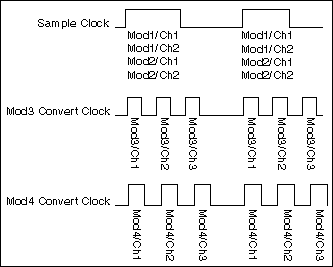Multiplexed Versus Simultaneous Sampling
S Series devices use simultaneous sampling. These devices have an ADC for each analog channel, which allows you to sample from all channels at the same time, as shown in the following figure.

Other devices, such as M Series and E Series devices, use multiplexed sampling. With this type of sampling, a single ADC is used for all analog input channels. These devices use both a sample clock and a convert clock. The sample clock initiates the acquisition of a sample from all channels in the scan list. The convert clock causes the ADC conversion for each individual channel. The following figure depicts a three-channel analog input task on a device that uses multiplexed sampling. Notice that, unlike S Series devices, the samples are not digitized simultaneously.

The convert clock must run faster than the sample clock to achieve the specified sample rate. For instance, if you specify a sample rate of 10 S/s for 8 analog input channels, the convert clock must run at least eight times the sample rate (80 Hz) to ensure that each channel is sampled 10 times a second. At faster sampling rates, you must also take settling time between channels into account.
C Series devices in a NI cDAQ-9172 chassis use both simultaneous and multiplexed sampling, where all devices in the chassis share the same sample clock. Devices, such as the NI 9215, with an ADC for each analog channel use simultaneous sampling. Devices with a single ADC sample in sequence, using multiplexed sampling. An example of such a device is the NI 9205.
Each multiplexed C Series device has a separate convert clock. The convert clock timing is based on the number of channels for that device in the task, not the total number of channels in the task. You can set the convert clock rate on a per-device basis using the Active Devices and AI Convert Rate attributes/properties on the DAQmx Timing property node. The following figure depicts a ten-channel analog input task on two simultaneous sampling C Series devices and two multiplexed sampling C Series devices with different AI convert rates:
